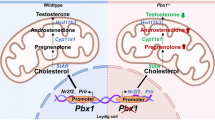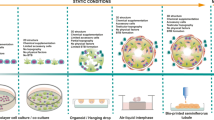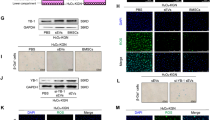Abstract
Testis-specific gene antigen 10 (TSGA10) plays an important role in spermatogenesis. However, the exact TSGA10 role and its relationship with the autophagy pathway in the process of spermatids differentiation/maturation is still not clear. Therefore, the present study evaluates the role of TSGA10 gene in the spermatid differentiation/maturation through its effect on autophagy and explores possible underlying pathway(s). Sperm samples from patients with teratospermia were collected. The mRNA and protein level of TSGA10 in these samples were assessed by real-time PCR and western blotting. Using the ingenuity pathway analysis (IPA) software, the gene network and interactions of TSGA10 involved in sperm maturation and autophagy were investigated. Based on these analyses, the expression levels of identified genes in patient’s samples and healthy controls were further evaluated. Moreover, using flow cytometry analysis, the levels of reactive oxygen species (ROS( production in teratospermic sperm samples were evaluated. The results showed that the expression levels of TSGA10 mRNA and protein decreased significantly in the teratospermic patients compared to controls (P < 0.05). Moreover, a significant reduction in the expression of the important genes involved in sperm maturation and autophagy was observed (P < 0.05). Also, the levels of ROS production in teratospermic sperm samples were shown to be significantly higher compared to those in normal sperms (P < 0.05). Our findings provide new evidence that simultaneous decrease in TSGA10 and autophagy beside the increased level of ROS production in sperm cells might be associated with the abnormalities in the spermatids differentiation/maturation and the formation of sperms with abnormal morphology.









Similar content being viewed by others
References
De Braekeleer M, Nguyen MH, Morel F, Perrin A. Genetic aspects of monomorphic teratozoospermia: a review. J Assist Reprod Genet. 2015;32:615–23.
Heller CH, Clermont Y. Kinetics of the germinal epithelium in man. Recent Prog Horm Res. 1964;20:545–75.
Amann RP, Hammerstedt RH, Veeramachaneni DN. The epididymis and sperm maturation: a perspective. Reprod Fertil Dev. 1993;5:361–81.
Chocu S, Calvel P, Rolland AD, Pineau C. Spermatogenesis in mammals: proteomic insights. Syst Biol Reprod Med. 2012;58(4):179–90.
Xu H, Yuan SQ, Zheng ZH, Yan W. The cytoplasmic droplet may be indicative of sperm motility and normal spermiogenesis. AsianJ Androl. 2013;15:799.
Huang SL, Chou TC, Lin TH, Tsai MS, Wang SH. Gcse, a novel germ-cell-specific gene, is differentially expressed during meiosis and gametogenesis. Reprod Sci. 2013;20(10):1193–206.
Zhang M, Jiang M, Bi Y, Zhu H, Zhou Z, Sha J. Autophagy and apoptosis act as partners to induce germ cell death after heat stress in mice. PLoS One. 2012;7:41412.
Shang Y, Wang H, Jia P, Zhao H, Liu C, Liu W, et al. Autophagy regulates spermatid differentiation via degradation of PDLIM1. Autophagy. 2016;12(9):1575–92.
Oh SY, Choi SJ, Kim KH, Cho EY, Kim JH, Roh CR. Autophagy-related proteins, LC3 and Beclin-1, in placentas from pregnancies complicated by preeclampsia. Reprod Sci. 2008;15(9):912–20.
Jiang P, Mizushima N. Autophagy and human diseases. Cell Res. 2014;24(1):69–79.
Bar-Yosef T, Damri O, Agam G. Dual role of autophagy in diseases of the central nervous system. Front Cell Neurosci. 2019;13:196.
Asgari R, Bakhtiari M, Rezazadeh D, Vaisi-Raygani A, Mansouri K. Autophagy related gene expression status in patients diagnosed with azoospermia: A cross-sectional study. J Gene Med. 2020;22(4):3161.
Eid N, Ito Y, Otsuki Y. Enhanced mitophagy in Sertoli cells of ethanol-treated rats: morphological evidence and clinical relevance. J Mol Histol. 2012;43:71–80.
Kanninen TT, de Andrade Ramos BR, Witkin SS. The role of autophagy in reproduction from gametogenesis to parturition. Eur J Obstet Gynecol Reprod Biol. 2013;171:3–8.
Modarressi MH, Cameron J, Taylor KE, Wolfe J. Identification and characterisation of a novel gene, TSGA10, expressed in testis. Gene. 2001;262:249–55.
Behnam B, Modarressi MH, Conti V, Taylor KE, Puliti A, Wolfe J. Expression of Tsga10 sperm tail protein in embryogenesis and neural development: from cilium to cell division. Biochem Biophys Res Commun. 2006;344:1102–10.
Tajaddini Mahani S, Behnam B, Abbassi M, Asgari H, Nazmara Z, Shirinbayan P, et al. Tsga10 expression correlates with sperm profiles in the adult formalin-exposed mice. Andrologia. 2016;48:1092–9.
Hagele S, Behnam B, Borter E, Wolfe J, Paasch U, Lukashev D, et al. TSGA10 prevents nuclear localization of the hypoxia-inducible factor (HIF)-1α. FEBS Lett. 2006;580:3731–8.
Behnam B, Mobahat M, Fazilaty H, Wolfe J, Omran H. TSGA10 is a centrosomal protein, interacts with ODF2 and localizes to basal body. J Cell Sci Ther. 2015;6:1.
Semenza GL. Targeting HIF-1 for cancer therapy. Nat Rev Cancer. 2003;3:721.
Chen N, Chen X, Huang R, Zeng H, Gong J, Meng W, et al. BCL-xL is a target gene regulated by hypoxia-inducible factor-1α. J Biol Chem. 2009;284:10004–12.
Gao P, Zhang H, Dinavahi R, Li F, Xiang Y, Raman V, et al. HIF-dependent anti tumorigenic effect of antioxidants in vivo. Cancer Cell. 2007;12:230e238.
Movafagh S, Crook S, Vo K. Regulation of hypoxia-inducible factor-1a by reactive oxygen species: new developments in an old debate. J Cell Biochem. 2015;116:696e703.
Mansouri K, Mostafie A, Rezazadeh D, Shahlaei M, Modarressi MH. New function of TSGA10 gene in angiogenesis and tumor metastasis: a response to a challengeable paradox. Hum Mol Genet. 2015;25:233–44.
Amoorahim M, Valipour E, Hoseinkhani Z, Mahnam A, Rezazadeh D, Ansari M, et al. TSGA10 overexpression inhibits angiogenesis of HUVECs: A HIF-2α biased perspective. Microvasc Res. 2020;128:103952.
Kruger TF, Acosta AA, Simmons KF, Swanson RJ, Matta JF, Veeck LL, et al. New method of evaluating sperm morphology with predictive value for human in vitro fertilization. Urology. 1987;30(3):248–51.
Rastogi RP, Singh SP, Häder DP, Sinha RP. Detection of reactive oxygen species (ROS) by the oxidant-sensing probe 2′, 7′-dichlorodihydrofluorescein diacetate in the cyanobacterium Anabaena variabilis PCC 7937. Biochem Biophys Res Commun. 2010;397(3):603–7.
Sikka SC. Oxidative stress and role of antioxidants in normal and abnormal sperm function. Front Biosci. 1996;1:e78–86.
Agarwal A, Tvrda E, Sharma R. Relationship amongst teratozoospermia, seminal oxidative stress and male infertility. Reprod Biol Endocrinol. 2014;12(1):45.
Marquez RT, Xu L. Bcl-2: Beclin 1 complex: multiple, mechanisms regulating autophagy/apoptosis toggle switch. Am J Cancer Res. 2012;2:214.
Parya RR, Mobasheri MB, Hashemzadeh-Chaleshtori M, Modarressi MH. Hypoxia-inducible factor α subunits are correlated with TSGA10 transcripts in HeLa, MCF7 and MDA-MB-231 cell lines. Basic Clin Cancer Res. 2018; 9.
Bohensky J, Shapiro IM, Leshinsky S, Terkhorn SP, Adams CS, Srinivas V. HIF-1 regulation of chondrocyte apoptosis: induction of the autophagic pathway. Autophagy. 2007;3:207–14.
Williams H, Johnson JL, Jackson CL, White SJ, George SJ. MMP-7 mediates cleavage of N-cadherin and promotes smooth muscle cell apoptosis. Cardiovasc Res. 2010;87:137–46.
Sha YW, Sha YK, Ji ZY, Mei LB, Ding L, Zhang Q, et al. TSGA10 is a novel candidate gene associated with acephalic spermatozoa. Clin Genet. 2017.
Ye Y, Wei X, Sha Y, Li N, Yan X, Cheng L, et al. Loss-of-function mutation in TSGA10 causes acephalic spermatozoa phenotype in human. Mol Genet Genom Med. 2020; 1284.
Zhang Q, Gao M, Zhang Y, Song Y, Cheng H, Zhou R. The germline-enriched Ppp1r36 promotes autophagy. Sci Rep. 2016;6(1):1–9.
Yin J, Ni B. Tian Z-q, Yang F, Liao W-g, Gao Y-q. Regulatory effects of autophagy on spermatogenesis. Biol Reprod. 2017;96:525–30.
Liu ML, Wang JL, Wei J, Xu LL, Yu M, Liu XM, et al. Tri-ortho-cresyl phosphate induces autophagy of rat spermatogonial stem cells. Reproduction. 2015;149:163–70.
Wang H, Wan H, Li X, Liu W, Chen Q, Wang Y, et al. Atg7 is required for acrosome biogenesis during spermatogenesis in mice. Cell Res. 2014;24:852.
Zheng H, Stratton CJ, Morozumi K, Jin J, Yanagimachi R, Yan W. Lack of Spem1 causes aberrant cytoplasm removal, sperm deformation, and male infertility. Proc Natl Acad Sci. 2007;104:6852–7.
Brachmann CB, Sherman JM, Devine SE, Cameron EE, Pillus L, Boeke JD. The SIR2 gene family, conserved from bacteria to humans, functions in silencing, cell cycle progression, and chromosome stability. Genes Dev. 1995;9:2888–902.
Smith JS, Brachmann CB, Celic I, Kenna MA, Muhammad S, Starai VJ, et al. A phylogenetically conserved NAD+-dependent protein deacetylase activity in the Sir2 protein family. Proc Natl Acad Sci. 2000;97:6658–63.
Liu C, Song Z, Wang L, Yu H, Liu W, Shang Y, et al. Sirt1 regulates acrosome biogenesis by modulating autophagic flux during spermiogenesis in mice. Development. 2017;144:441–51.
Xu X, Toselli PA, Russell LD, Seldin DC. Globozoospermia in mice lacking the casein kinase II α′ catalytic subunit. Nat Genet. 1999;23:118–21.
Modarres P, Tavalaee M, Ghaedi K, Nasr-Esfahani MH. An overview of the globozoospermia as a multigenic identified syndrome. Int J Fertil Steril. 2019;12:273.
Al Quobaili F, Montenarh M. CK2 and the regulation of the carbohydrate metabolism. Metabolism. 2012;61:1512–7.
Song H, Pu J, Wang L, Wu L, Xiao J, Liu Q, et al. ATG16L1 phosphorylation is oppositely regulated by CSNK2/casein kinase 2 and PPP1/protein phosphatase 1 which determines the fate of cardiomyocytes during hypoxia/reoxygenation. Autophagy. 2015;11:1308–25.
Schuchman EH, Levran O, Pereira LV, Desnick RJ. Structural organization and complete nucleotide sequence of the gene encoding human acid sphingomyelinase (SMPD1). Genomics. 1992;12:197–205.
Teodosio C, Garcia-Montero AC, Jara-Acevedo M, Sanchez-Munoz L, Pedreira CE, Alvarez-Twose I, et al. Gene expression profile of highly purified bone marrow mast cells in systemic mastocytosis. J Allergy Clin Immunol. 2013;131:1213–24.
Agarwal A, Aitken RJ, Alvarez JG. Studies on men’s health and fertility. In: Oxidative stress in applied basic research and clinical practice: New York. Springer Sci Bus Media, LLC: Dordrecht, Heidelberg, London; 2012.
Thompson A, Agarwal A, du Plessis SS. Physiological role of reactive oxygen species in sperm function: a review. In: Parekatil SJ, Agarwal A, editors. Antioxidants in male infertility: a guide for clinicians and researchers. New York: Springer Sci Bus Media; 2013. p. 69–89.
Gibson SB. A matter of balance between life and death: targeting reactive oxygen species (ROS)-induced autophagy for cancer therapy. Autophagy. 2010;6:835–7.
Li L, Ishdorj G, Gibson SB. Reactive oxygen species regulation of autophagy in cancer: Implications for cancer treatment. Free Radic Biol Med. 2012;53:1399–410.
De Lamirande E, Gagnon C. Impact of reactive oxygen species on spermatozoa: a balancing act between beneficial and detrimental effects. Hum Reprod. 1995;10(1):15–21.
Kothari S, Thompson A, Agarwal A, du Plessis SS. Free radicals: their beneficial and detrimental effects on sperm function. Indian J Exp Biol. 2010;48(5):425–35.
Yun HR, Jo YH, Kim J, Shin Y, Kim SS, Choi TG. Roles of autophagy in oxidative stress. Int J Mol Sci. 2020;21(9):3289.
Balaban RS, Nemoto S, Finkel T. Mitochondria, oxidants, and aging. Cell. 2005;120:483–95.
Brand MD. Mitochondrial generation of superoxide and hydrogen peroxide as the source of mitochondrial redox signaling. Free Radic Biol Med. 2016;100:14–31.
Lopez-Fernandez C, Crespo F, Arroyo F, Fernandez JL, Arana P, Johnston SD, et al. Dynamics of sperm DNA fragmentation in domestic animals: II. The stallion Theriogenology. 2007;68:1240–50.
Funding
This study has been supported by Kermanshah University of Medical Sciences, Kermanshah, Iran (grant number: 96118).
Author information
Authors and Affiliations
Corresponding author
Ethics declarations
The present study has been approved by the Ethics Committee of the Kermanshah University of Medical Sciences (IR.KUMS.REC.1396.1).
Conflict of Interest
The authors declare no competing interests.
Additional information
Publisher’s Note
Springer Nature remains neutral with regard to jurisdictional claims in published maps and institutional affiliations.
Rights and permissions
About this article
Cite this article
Asgari, R., Bakhtiari, M., Rezazadeh, D. et al. TSGA10 as a Potential Key Factor in the Process of Spermatid Differentiation/Maturation: Deciphering Its Association with Autophagy Pathway. Reprod. Sci. 28, 3228–3240 (2021). https://doi.org/10.1007/s43032-021-00648-6
Received:
Accepted:
Published:
Issue Date:
DOI: https://doi.org/10.1007/s43032-021-00648-6




